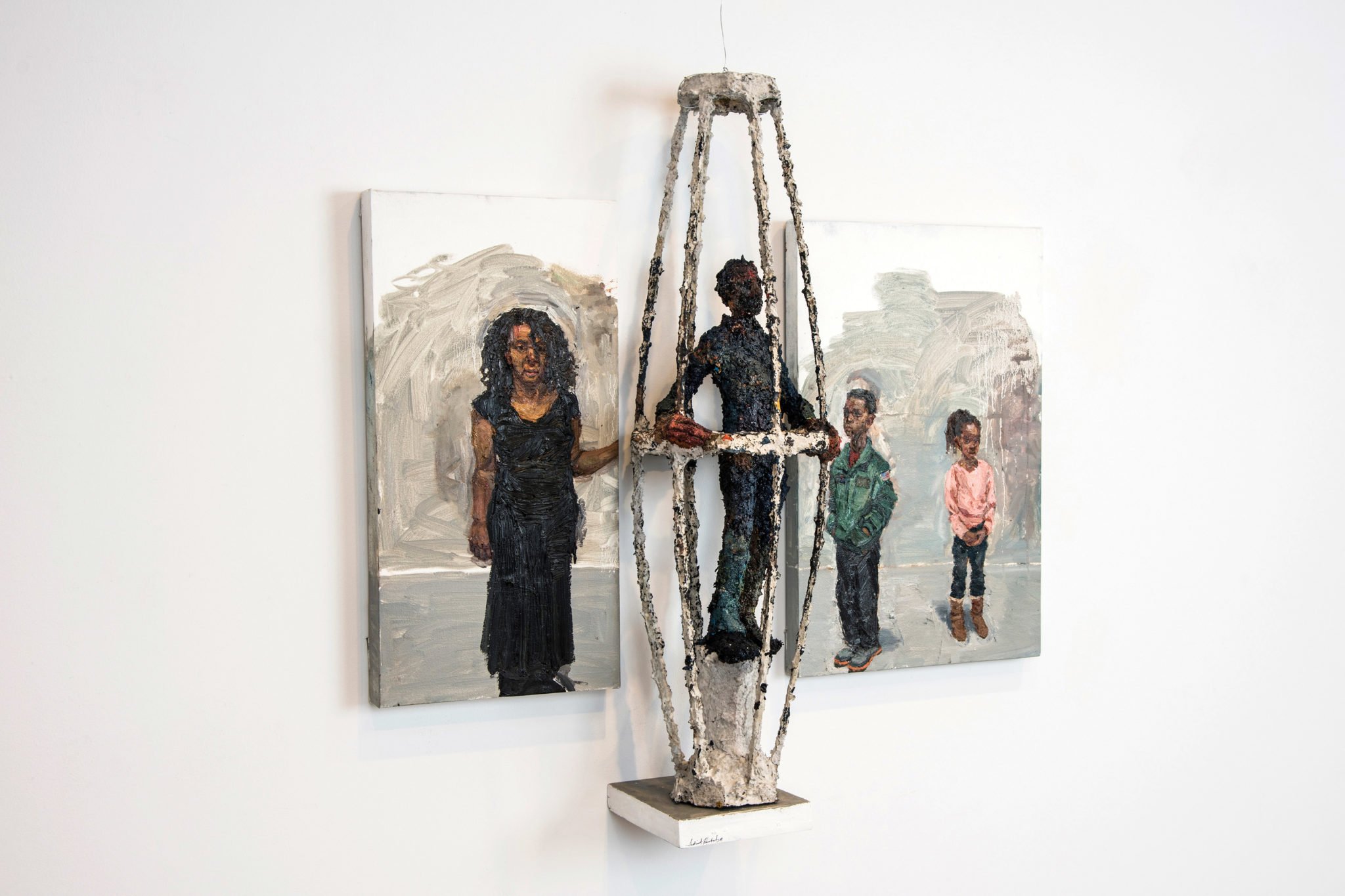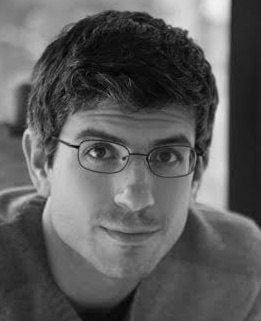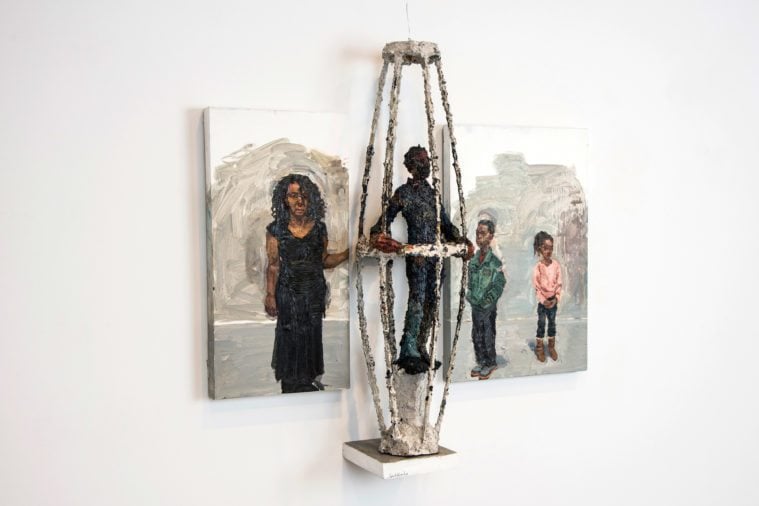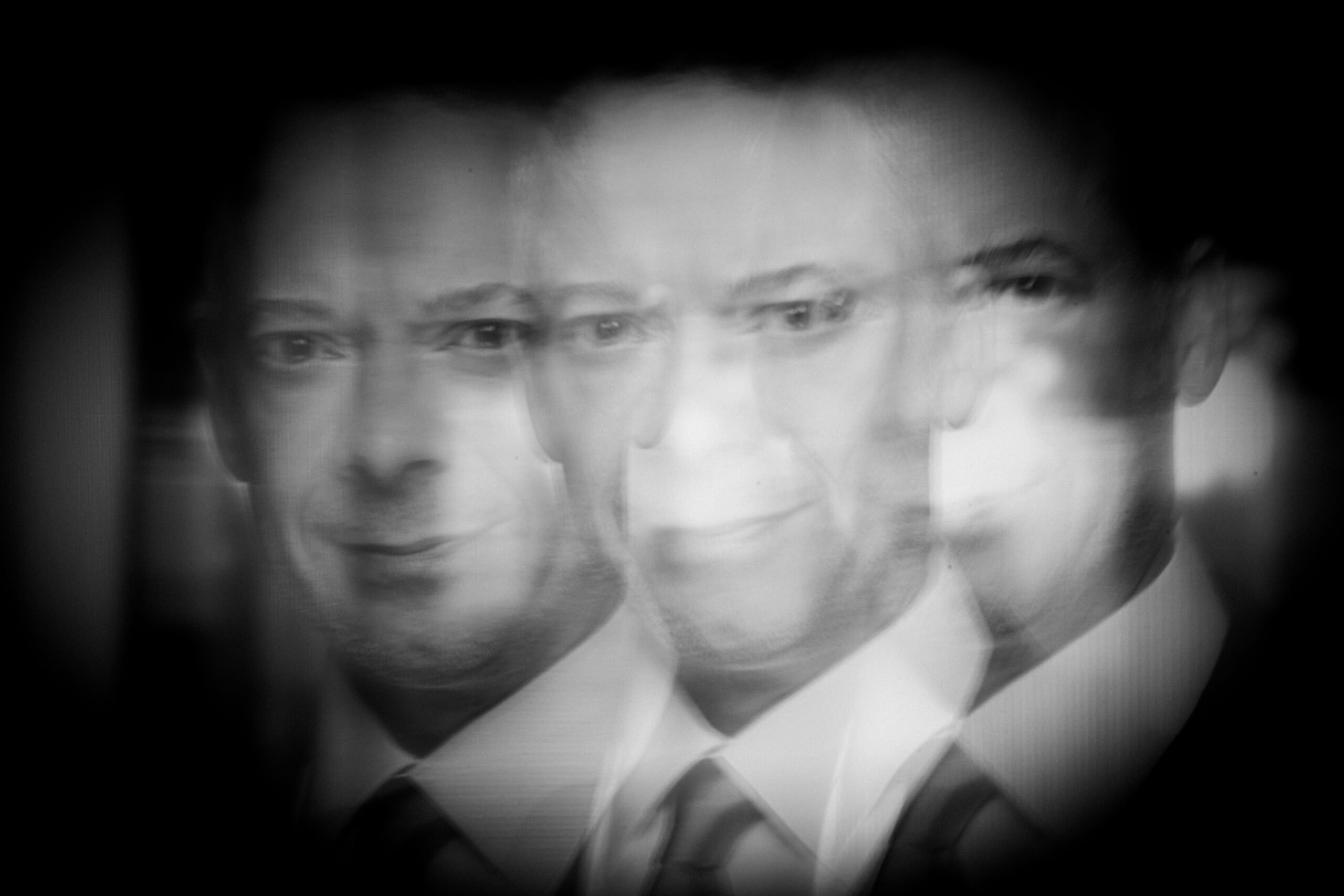
Rattling Cages
Dallas artist Sedrick Huckaby’s new work portrays the grief of incarceration for black men and their families.

A version of this story ran in the August 2016 issue.
Rattling Cages
Dallas artist Sedrick Huckaby’s new work portrays the grief of incarceration for black men and their families.
I came across Sedrick Huckaby’s new mixed-media work, “If perhaps by chance, I find myself encaged,” while wandering from booth to booth at the 2016 Dallas Art Fair. Huckaby’s oil painting with sculpture depicts an African-American family, the father in a three-dimensional cage, the mother and children standing nearby in two-dimensional space. It stood out not just for its relatively straightforward grappling with social issues but also for its warmth, humanity and sense of lived-in familiarity with its subject matter.
None of these are standard characteristics for artwork in a setting like the moneyed fair. First of all, it’s hard to get an energy millionaire interested in buying a canvas that seems politically charged; it’s just no good for showing off to company. Furthermore, if a wall hanging is to signal the wealth of the art buyer, it should convey as much exclusivity as possible, whether through abstraction or the impenetrable irony of certain strains of conceptual art. Finally, if art must be autobiographical — and still have market value — it should link to vogue theories of identity, lest it begin to seem merely homemade.
“If perhaps by chance, I find myself encaged” flouts these and other unwritten rules of the present-day art world, but Huckaby is no outsider: He got his MFA from art-star incubator Yale. He knows the rules of the game well enough but he strikes his own sincere path, creating a body of work that reflects a rich inner life in tune with a specific community and corner of the world. For Huckaby, that has meant not just taking a step back from the collector-driven conventions that made the 2016 Dallas Art Fair a less-than-inspiring affair, but also turning his back on certain trends in art academia and theory.
“When people in a position to make decisions about what is valuable and what is not, what is of substance and what is not, say that something has to be academic or has to have a certain line of thinking, they really encourage certain thought patterns and discourage others,” Huckaby told me by phone. “I did a whole project of talking to people in the community, just walking around and talking to people. People aren’t going around talking about their ‘black bodies.’ People are having issues with fatherhood and families staying together — these basic things.” The result of that research, a lithograph series called “The 99%,” showed at UNT ArtSpace Dallas last year. It has been described in the press as an “installation of portraits in a quilt-like assemblage of shifting color and scale” that aimed at “affirming people who might otherwise remain unseen or unimportant.”
After completing his education at Yale and in Europe, Huckaby returned home to the Fort Worth area, settling in Benbrook, 10 minutes from the neighborhood where he grew up. He teaches at the University of Texas at Arlington. There, Huckaby has grounded himself in a buzzword-free set of art-making values, articulated in the title of his spring show at Valley House Gallery in Dallas: “Three Forbidden ‘F’ Words: Faith, Family, and Fathers.”

In his work, he shifts between figurative art, portraiture of himself and the people in his life, and abstraction, including a well-received series of paintings of traditional quilts. He’s won a Guggenheim Fellowship and has works in the permanent collection of the Whitney Museum in New York City and the Museum of Fine Arts in Boston. His self-portrait, “Sedrick, Sed, Daddy,” hangs in the National Portrait Gallery in Washington, D.C., one of seven winners of the 2016 Outwin Boochever Portrait Competition.
That show will travel to the Art Museum of South Texas in Corpus Christi in 2017.
“Would one say that he is out of step with trends in the art world? I think artists create the trends,” says Benito Huerta, co-founder of the erstwhile Texas art journal Art Lies and curator of a 2011 show of Huckaby’s paintings at the Gallery at UT-Arlington. “I think artists who are very committed to ideas end up following their own path. Sedrick has gotten some attention and notice in the art world because of the quality of his painting style and his ideas, and he’s very much grounded in the things that matter to him, which I think are important.”
Huckaby brilliantly illuminates the hot-button civil rights issue of our time — the brutally unequal experiences of black men with the American criminal justice system — through a family portrait.
Working in sculpture is unusual for Huckaby, who is much better known for his paintings. In a sense, however, he has always embraced three dimensions. “He’s very skilled at applying paint to canvas,” Huerta says. “That sounds like a light statement, but it isn’t. For a lot of people now, the painting surface is relatively flat. What he does is more impasto. It gives visual weight to the work. It feels a lot more 3-D even on a 2-D surface, because of the thickness of the paint.”
It’s easy to interpret the work as stemming from Huckaby’s fear, as a black man in America, of false imprisonment. He confirms that the family depicted is his own; he has children 7 and 10 years old, and his wife, Letitia, is another well-known Metroplex artist. For Huckaby, incarceration is more than an abstract concern: He says his young cousin was recently jailed for no reason other than being at the wrong place at the wrong time and unable to afford bail. “I’m not a political artist,” he says. “But if I deal with an issue like incarceration, and then that becomes an issue of the day, suddenly it’s political. For me, it’s personal.”
Huckaby stresses, too, that the cage he depicts is not just meant literally. “I was thinking about issues of incarceration, and I was thinking about other issues that might hamper or encage a person, particularly from a father’s perspective,” he says. He offers a long list of things that might make a person feel boxed in: mentality, drugs, education or lack thereof, and other social or psychological restraints. “Literally, some people might feel like it’s a stigma just to be an African American, alive and trying to do well in certain sectors of the United States,” he adds. “There’s a lot of things that cage could be.”


